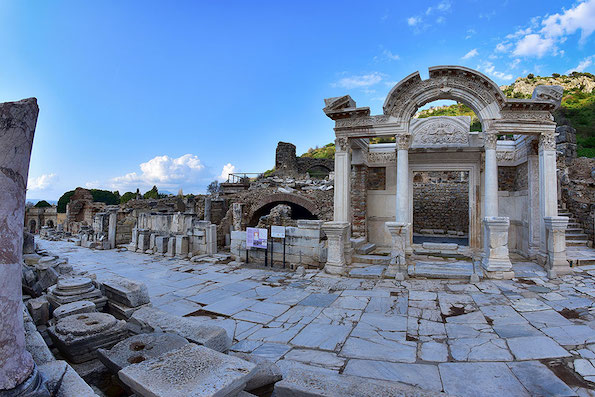St. John in Ephesus
St. John passed through Ephesus during his missionary journeys and stayed there for three years, accompanying the Virgin Mary. He is thought to have written his Gospel in Ephesus and to have died there too. Emperor Justinian erected a large Basilica of St. John above his tomb in the 6th century AD.
The Basilica of St. John was cross-shaped and 130 m long. There was an atrium on the front side and the church consisted of six vaults supported by huge pillars that had been erected between the naves. Two floors of columns were built between the naves and the monograms of Justinian and his wife Theodora had been engraved on the bottom row of columns.
Recent excavations have brought to light a baptistery, a pool and a chapel with frescoes depicting Christian saints.
Part of the Basilica’s brick foundations and marble walls have been rebuilt and it is said that if it were fully restored, it would be the seventh largest cathedral in the world.
St. John’s Basilica is located 3.5 km away from the ancient site of Ephesus, on the slopes of Ayasoluk Mountain. It was one of the most sacred places during the Medieval Age, attracting a large number of pilgrims. However, it was destroyed due to the Arab invasions and was converted into a mosque in 1330. In 1402, it was entirely destroyed by Tamerlane’s Mongol army.
The church of the Virgin Mary in Ephesus
The church of the Virgin Mary is located near the bathing port of the ancient city of Ephesus. It was a 260 m long basilica that was initially used as a medical center and a small chapel was added to it in the 10th century AD. It can be accessed through an atrium that had been paved with marble slabs. Metal crosses and rosettes adorn its walls and a baptismal pool had been built to the north of the church. A large part of the walls and pillars have survived to the present day.
The Council of Ephesus met there in 431 AD to discuss the role of St. Mary as the Mother of God. They agreed at least on the fact that she arrived in Ephesus accompanied by St. John and that she died there.
This is a very important church for Christianity because it was the first dedicated to the Virgin Mary. The Council of Ephesus and the Synod declared the church to be the center of Christianity in 449 AD.
According to recent excavations, the church was built to the south of the portico of the Temple of Hadrian Olympios and its foundations can still be seen today.


0 Comment